Biodiversity
Daifuku Group Action Guidelines for Biodiversity
Basic Approach
The Daifuku Group recognizes that addressing biodiversity conservation is an important theme to be addressed in order to create a sustainable society. Under the Daifuku Group Environmental Policy and the Daifuku Environmental Vision 2050, we aim to achieve zero negative impacts on natural capital by implementing specific annual plans based on a medium- to long-term perspective.
Action Guidelines
- Understanding
-
- Through systematic training and awareness-raising, all Group executives and employees will gain a better understanding of the sustainable use of ecosystem services and the importance of biodiversity conservation.
- By referring to international guidelines, we will work to understand and evaluate the impact on biodiversity of all of our business activities, from the procurement of raw materials to the disposal of products.
- Acting
-
- We will comply with laws, regulations, and international rules related to biodiversity conservation, and we will collaborate and cooperate with a diverse range of stakeholders, including governments, NPOs and NGOs, local residents, business partners, and employees.
- We will minimize negative impacts on biodiversity by reducing CO2 emissions in manufacturing, promoting resource recycling, and reducing hazardous substances.
- We will consider the ecosystems of the surrounding area in our use of land, and we will implement initiatives at each of our sites that will lead to the conservation of biodiversity.
- Disclosing
-
- We will make efforts to communicate with stakeholders by actively disclosing information on natural capital as well as information on our biodiversity conservation efforts.
Established: August 31, 2023
Major Initiatives
The relationship between Daifuku and biodiversity
In order to clarify the relationship between business activities and ecosystems, Daifuku has mapped the interaction of product processes, land use, and other aspects with ecosystems. Based on this map, Daifuku notes the impact on ecosystems by the land use at Shiga Works, which is endowed with abundant nature, and is conducting business activities that take biodiversity into account.
Please enlarge the screen to view
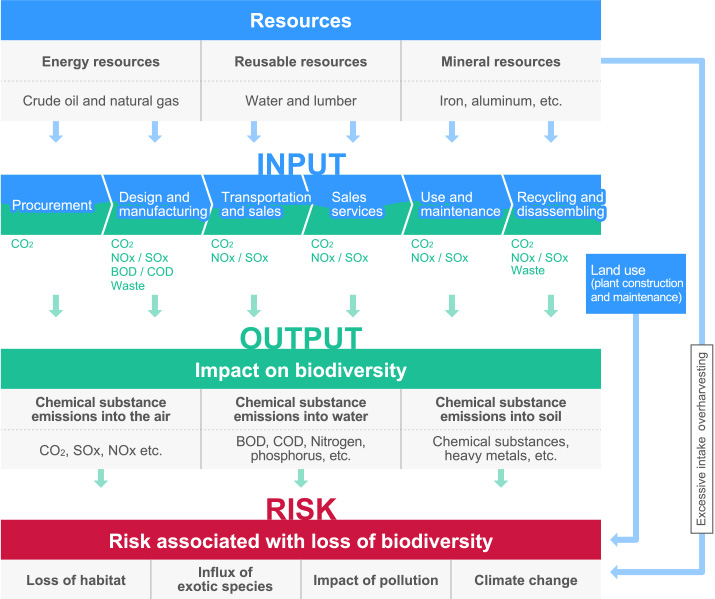
Conservation activities at Shiga Works
In terms of site area, Shiga Works is one of the largest factories in Shiga Prefecture. A survey of ecosystems within Shiga Works confirmed more than 1,000 native species as well as over 70 species of wildlife listed in the Japanese Red List (compiled and maintained by the Ministry of the Environment) and the Shiga Prefecture Red Data Book. In order to preserve this precious natural environment for future generations, we are pursuing various conservation initiatives through the Yui Project,* which promotes communication both within and outside the company.
- *Yui means “to bring together," and the project is a compilation of various activities that connect water with greenery, people with nature, and people to people.
Results of ecosystems survey (endangered species)
Listed below are the species of wildlife that inhabit or grow within the Shiga Works premises and are classified as endangered in the Japanese Red List 2020.
- Japanese Red List 2020
- Threatened - Vulnerable (VU): Species with a high risk of extinction in the wild.
Near Threatened (NT): Species that do not qualify as threatened at present but may be vulnerable to endangerment in the near future.
(As of April 2023)
| Category | Classification | Species | Number of species |
|---|---|---|---|
| Threatened - Vulnerable (VU) | Birds | Peregrine falcon | 1 |
| Amphibians | Yamato salamander | 1 | |
| Insects | Polyrhachis lamellidens (spiny ant) | 1 | |
| Plants | Golden orchid, Chinese bellflower | 2 | |
| Near Threatened (NT) | Birds | Greater white-fronted goose, crested honey buzzard, Eurasian sparrowhawk, northern goshawk | 4 |
| Reptiles | Japanese pond turtle | 1 | |
| Amphibians | Black-spotted pond frog | 1 | |
| Insects | Aeschnophlebia anisoptera (dragonfly), asiagomphus pryeri (dragonfly), trigomphus interruptus (dragonfly), trigomphus ogumai (dragonfly), xenocorixa vittipennis (water boatman), catocala actaea (moth), helochares striatus (water beetle), laccobius inopinus (water beetle), bombus ignitus (bumblebee) | 9 | |
| Plants | Agrostis valvata, yellow bladderwort | 2 | |
| Total | 22 | ||
-

Peregrine falcon
-

Chinese bellflower
-

Japanese pond turtle
-

Trigomphus ogumai
-

Golden orchid
-

Black-spotted pond frog
-

Polyrhachis lamellidens
-

Yellow bladderwort
Yui no Mori
As part of the Yui Project, we constructed Yui no Mori (yui means “bring together” and mori means “forest”), which is located within Shiga Works and comprised of conservation ponds, a learning center, and more. It is used as a place for learning within and outside the company, as well as for the biodiversity conservation of plants and animals such as a Japanese red pine forest unique to the region and the rare species of Yamato salamander. In fiscal 2021, we removed dead pine trees and laid woodchips along the Yui no Mori roadside.
Breeding of Yamato salamanders in conservation ponds (artificial ponds)
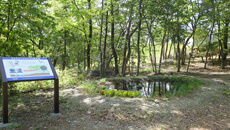
Conservation pond
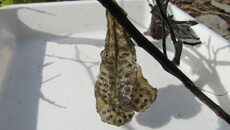
Salamander eggs in the conservation pond
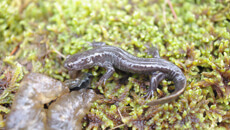
Adult Yamato salamander
We are working to preserve the endangered Yamato salamander. To ensure a stable habitat, a conservation pond was constructed in 2014, and we have been relocating the larvae and eggs that inhabit the Shiga Works premises since. We have also confirmed spawning and hatching in the conservation pond every year since fiscal 2021. In addition, there is a risk that the redevelopment of Shiga Works could lead to a reduced habitat for wild Yamato salamanders. To combat this, we are implementing ongoing initiatives in fiscal 2024 to maintain and improve their natural habitat, including creating a new habitat outside of the conservation pond into which larvae will be released.
Conserved Area Certification
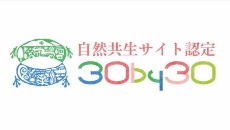
Conserved Area Certification
In September 2024, Yui no Mori was certified as a conserved area by the Ministry of Environment, Government of Japan. This is a site certification system in which the Ministry of Environment certifies areas where biodiversity is being conserved through private or other initiatives. This certification system was launched in 2023 in order to achieve the international target of conserving the ecosystems of at least 30% of land and sea areas by 2030 (known as the 30by30 target).
Scarlet dwarf dragonfly habitat preservation
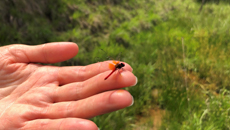
Scarlet dwarf dragonfly (male)
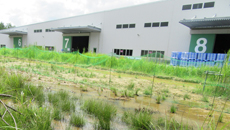
New wetlands
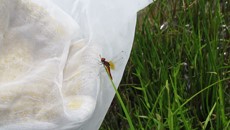
Transfer of adult insects
As part of the wetlands in which scarlet dwarf dragonflies have been confirmed to inhabit will be lost during the redevelopment of Shiga Works, we are working to secure a new habitat while minimizing this loss. In fiscal 2023, we created new wetlands using mountain spring water, silver grass, and sedges, and we transferred eggs, larvae, and adult insects to this new area along with hydrophytes and aquatic plants from the existing habitat. We also set up a net about one meter tall to enclose the wetlands. The plants that were transferred here are flourishing, and it has become an environment in which the dragonflies can settle easily. In fiscal 2024, we conducted a habitat survey in the newly created wetlands, and we confirmed that adult scarlet dwarf dragonflies are inhabiting the area.
Creating opportunities to interact with nature
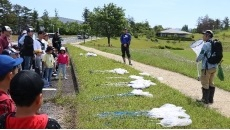
At Shiga Works, we hold nature observation events with experts so that employees have opportunities to interact with the many plants and animals that inhabit the area. We also hold events such as Christmas wreath making using natural materials procured on site.
Conservation activities at global subsidiaries

Daifuku Intralogistics India Private Limited (ILIN) has been making efforts in biodiversity conservation for over ten years through the planting of trees. By actively planting native plants that are well-suited to the local climate and soil, ILIN is contributing to the conservation of the local ecosystem while also creating a pleasant working environment surrounded by greenery.
Collaborations with local communities
Participation in the Biodiversity Biwako Network’s dragonfly conservation efforts through corporate collaboration
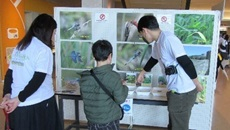
In 2016, neighboring companies* of Shiga Works launched the Biodiversity Biwako Network, which is engaged in biodiversity conservation activities using the 100 dragonfly species confirmed in the prefecture as indicators. The project, entitled Operation Dragonfly 100: Save Shiga’s Dragonflies, has three strategies: search for the 100 dragonfly species in Shiga Prefecture, protect them, and educate the public about them. We are also engaged in regular monitoring at the company site, maintenance of biotopes and extermination of invasive alien species, nature observation meetings, exhibitions and presentations of our activities, as well as understanding of the current state of nature in the surrounding area.
- *Currently, the following five companies are actively involved: Asahi Kasei Corporation; Asahi Kasei Juko Co., Ltd.; Sekisui Jushi Corporation; Daihatsu Motor Co., Ltd.; and Daifuku Co., Ltd.
Blue Ocean Initiative (BOI)
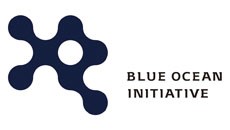
Daifuku has been a supporting member of the Blue Ocean Initiative (BOI), a blue action platform formed by a coalition of corporations, since 2023. The BOI is expanding the scope of its activities to achieve sustainable and effective ocean conservation and prosperity through multifaceted interactions and business co-creation with all stakeholders that have ties with the ocean.
Members of the Osaka Bay Blue Carbon Ecosystem Alliance (MOBA)
Daifuku has endorsed the Osaka Bay Blue Carbon Ecosystem Alliance (MOBA) of Osaka Prefecture since 2024. This Alliance endorses the creation of a blue carbon ecosystem in Osaka Bay in order to realize the Osaka Bay MOBA Link Initiative, which will connect Osaka Bay with a corridor of blue carbon ecosystems (seaweed beds and tidal flats that absorb and store CO2). The Alliance carries out its activities with the cooperation of its members, which consist of companies, organizations, research institutes, and government agencies.
Declaration of Support for Osaka Biodiversity
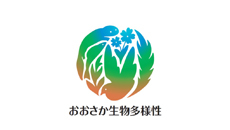
Daifuku Group company Contec Co., Ltd. endorses Osaka Prefecture’s biodiversity preservation activities. In 2023, we submitted a Declaration of Support for Osaka Biodiversity to the Osaka Prefectural Government, and its registration has been approved. This registration system enables the Osaka Prefectural Government to support the efforts of companies and organizations within the prefecture that declare their commitment to actively work toward conserving biodiversity.
